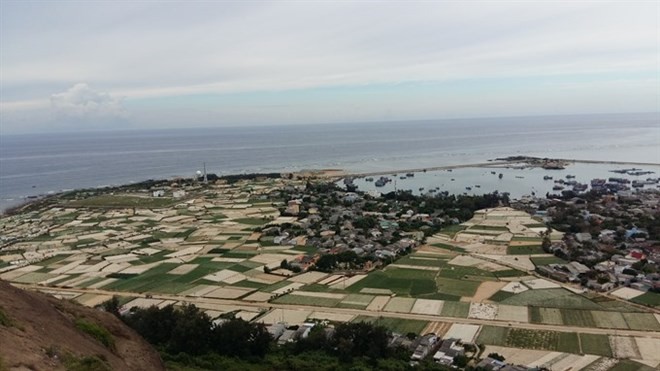
“Many efforts have been recorded by the regional coordination management board since the first forum was held in 2014. However, poor connection of strategic traffic roads, including the National Highway, Coastal Highway, Ho Chi Minh Trail and north-south railway, have prevented the region from fast growth,” Hue said.
Favourable connection of roads, airports, sea ports and economic and industrial zones will create more power for the region in the coming decades, he added.
He suggested the forum discuss how to build an effective mechanism for cooperation among the provinces to boost their advantages in marine economy and tourism, saying the region could contribute as much as 70 percent to the country’s economic growth.
The head of the Vietnam Institute of Economics, Tran Dinh Thien, said the development of the coastal central region has not reached its target since the regional coordination management board was established six years ago.
“More than 40 industrial zones (IZs) and six economic zones (EZs) were built in the region, but income per capita in the region is not much higher than the country’s average income,” Thien said. “A lack of international-standard centres for sports, shopping, trade, night recreation and finance has hindered the region from becoming an attractive destination for international tourists.”
Thien also pointed to the lack of coordination among provinces as a major hindrance to economic growth. Thua Thien-Hue province had developed the Chan May-Lang Co deep-sea port in the region but neighbouring Da Nang plans to build its own Lien Chieu port as a key logistics centre just 20km away.
“Each province plans to build its own deep sea port, international airport or industrial zones, while no connections are planned to share the advantages of infrastructure investment,” he explained.
The coastal central region has six airports, 13 seaports, six coastal economic zones, a high-tech park and 14 national roads.
Thien suggested the region should be restructured, based on the advantage of each province. “We can arrange several provinces with the same advantages (sea ports, airports and economic zones) in a sub-zone,” he suggested.
Tran Du Lich, head of the central region’s Development Consultancy Council, said the region has tremendous potential for marine economy development – ship-building, fisheries, logistics, coastal economic zones, and island and sea tourism.
Dr. Huynh The Du from Fulbright University Vietnam said many provinces offer free land rent to attract investors, but investors are never punished for failing to move forward with promised projects or for long delays. He also suggested the region needs only one deep-sea port.
A quick survey presented by economist Vo Tri Thanh at the forum showed that nearly 80 percent of participants agreed that poor connections and underdeveloped links among provinces in the region are major barriers to growth.
The central coastal region had an average growth of 8.4 percent, earning revenues of 5.8 billion USD last year.
Favourable connection of roads, airports, sea ports and economic and industrial zones will create more power for the region in the coming decades, he added.
He suggested the forum discuss how to build an effective mechanism for cooperation among the provinces to boost their advantages in marine economy and tourism, saying the region could contribute as much as 70 percent to the country’s economic growth.
The head of the Vietnam Institute of Economics, Tran Dinh Thien, said the development of the coastal central region has not reached its target since the regional coordination management board was established six years ago.
“More than 40 industrial zones (IZs) and six economic zones (EZs) were built in the region, but income per capita in the region is not much higher than the country’s average income,” Thien said. “A lack of international-standard centres for sports, shopping, trade, night recreation and finance has hindered the region from becoming an attractive destination for international tourists.”
Thien also pointed to the lack of coordination among provinces as a major hindrance to economic growth. Thua Thien-Hue province had developed the Chan May-Lang Co deep-sea port in the region but neighbouring Da Nang plans to build its own Lien Chieu port as a key logistics centre just 20km away.
“Each province plans to build its own deep sea port, international airport or industrial zones, while no connections are planned to share the advantages of infrastructure investment,” he explained.
The coastal central region has six airports, 13 seaports, six coastal economic zones, a high-tech park and 14 national roads.
Thien suggested the region should be restructured, based on the advantage of each province. “We can arrange several provinces with the same advantages (sea ports, airports and economic zones) in a sub-zone,” he suggested.
Tran Du Lich, head of the central region’s Development Consultancy Council, said the region has tremendous potential for marine economy development – ship-building, fisheries, logistics, coastal economic zones, and island and sea tourism.
Dr. Huynh The Du from Fulbright University Vietnam said many provinces offer free land rent to attract investors, but investors are never punished for failing to move forward with promised projects or for long delays. He also suggested the region needs only one deep-sea port.
A quick survey presented by economist Vo Tri Thanh at the forum showed that nearly 80 percent of participants agreed that poor connections and underdeveloped links among provinces in the region are major barriers to growth.
The central coastal region had an average growth of 8.4 percent, earning revenues of 5.8 billion USD last year.
























